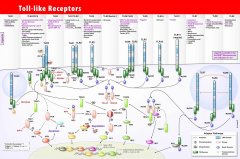
|

|
 [冷冻消融]
冷冻消融与肿瘤免疫
日期:2021-09-22 22:50:58
点击:135
好评:0
[冷冻消融]
冷冻消融与肿瘤免疫
日期:2021-09-22 22:50:58
点击:135
好评:0
冷冻消融 Cryoablation Preserves intracellular contents via cell death by necrosis (冷冻)通过使细胞因坏死/死亡来保存细胞内内容物 Intracellular contents (Damage Associated Molecular Patterns DAMPs) will be fagocytized by antigen presenting...
 [微波消融]
肿瘤介入技术对免疫的影响:微波
日期:2021-09-15 22:08:20
点击:99
好评:0
[微波消融]
肿瘤介入技术对免疫的影响:微波
日期:2021-09-15 22:08:20
点击:99
好评:0
肝癌 Thermal ablative therapies are standard treatments for localized hepatocellular carcinoma (HCC). 热消融治疗是局部肝细胞癌(HCC)的标准治疗方法。 In addition to local tumor destruction, ablation leads to abscopal effects in distant lesio...
 [TARE的免疫响应]
TARE的免疫相应
日期:2021-05-13 10:16:37
点击:66
好评:0
[TARE的免疫响应]
TARE的免疫相应
日期:2021-05-13 10:16:37
点击:66
好评:0
Yttrium90(90Y)经动脉放射栓塞(TARE)(也称为选择性内放射治疗)已成为治疗HCC(36-40)和其他癌症(41-45)的常用方法。电离辐射的抗肿瘤作用在很大程度上归因于它通过癌细胞(46)的直接DNA损伤来诱导肿瘤细胞死亡的能力。 除了其局部抗癌功效外,电离辐...
 [TACE的免疫反应]
TACE的免疫响应
日期:2021-05-13 09:58:14
点击:169
好评:0
[TACE的免疫反应]
TACE的免疫响应
日期:2021-05-13 09:58:14
点击:169
好评:0
At present, the largest application of transarterial chemoembolization (TACE) of tumors is for hepatocellular carcinoma (HCC). Several lines of evidence support a role for targeting the immune system in HCC. Patients with HCC exhibit a 66%...
 [消融免疫响应]
消融的免疫响应
日期:2021-05-05 22:26:15
点击:95
好评:0
[消融免疫响应]
消融的免疫响应
日期:2021-05-05 22:26:15
点击:95
好评:0
当前,肿瘤破坏技术,如热消融、化学消融或放射栓塞、不可逆电穿孔和高强度聚焦超声,已成功用于治疗一系列恶性肿瘤。虽然消融技术在技术和诱导细胞死亡的机制上种类多样,但它们有一个关键特征:创造消融肿瘤后残余物质(7)的可用性。 消融物质可诱导免疫...
 [用肿瘤介入技术刺激免疫系统]
用肿瘤介入治疗技术刺激免疫反应
日期:2021-05-05 22:21:29
点击:186
好评:0
[用肿瘤介入技术刺激免疫系统]
用肿瘤介入治疗技术刺激免疫反应
日期:2021-05-05 22:21:29
点击:186
好评:0
当前,肿瘤破坏技术,如热消融、化学消融或放射栓塞、不可逆电穿孔和高强度聚焦超声,已成功用于治疗一系列恶性肿瘤。虽然消融技术在技术和诱导细胞死亡的机制上种类多样,但它们有一个关键特征:创造消融肿瘤后残余物质(7)的可用性。 消融后残余物质可诱...